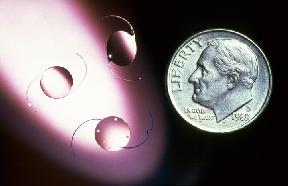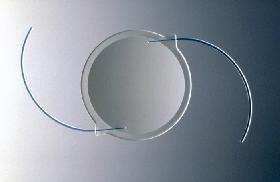Cataract
What is a Cataract?
A cataract is a clouding of the normally clear lens of the eye. It can be
compared to a window that is frosted or steamed.  There
are many misconceptions about cataracts. It is not a film over the eye nor is it
caused by overusing the eyes. It is not a cancer and does not spread from one
eye to the other. It does not cause irreversible blindness. Symptoms related to
cataract include a painless blurring of vision associated with glare and light
sensitivity. Patients frequently have to change their eyeglass prescription and
on occasion will even notice double vision in one eye. They frequently need
brighter light to read and have poor night vision. They may even complain of
fading or yellowing of colors. The amount and pattern of this cloudiness varies
within the lens itself. If the cloudiness is not to the center of the lens, you
may not be aware that a cataract is present.
There
are many misconceptions about cataracts. It is not a film over the eye nor is it
caused by overusing the eyes. It is not a cancer and does not spread from one
eye to the other. It does not cause irreversible blindness. Symptoms related to
cataract include a painless blurring of vision associated with glare and light
sensitivity. Patients frequently have to change their eyeglass prescription and
on occasion will even notice double vision in one eye. They frequently need
brighter light to read and have poor night vision. They may even complain of
fading or yellowing of colors. The amount and pattern of this cloudiness varies
within the lens itself. If the cloudiness is not to the center of the lens, you
may not be aware that a cataract is present.
What Causes Cataracts?
The most common type of cataract is related to aging of the eyes, but other
causes include a positive family history, other medical problems including
diabetes and inflammatory eye diseases, injury to the eye, and perhaps
medications such as steroids. Long term unprotected exposure to sunlight and
previous eye surgery have all been implicated in the origin and progression of
cataracts. The only way a cataract can be detected is by a thorough examination
by your ophthalmologist (medical eye doctor). He or she can detect the presence
and extent of the cataract as well as any other condition that may be causing
blurred vision or discomfort.
Cataracts develop differently in individuals and may even develop differently
between the two eyes. Most cataracts are associated with the aging process and
gradually get worse over a period of years. Other cataracts, especially in
younger people and people with diabetes, may progress rapidly over a few months
causing a worsening of vision. It is not possible to predict how fast cataracts
will develop in any given patient. Surgery is the only way your ophthalmologist
can remove a cataract, however, if symptoms from the cataract are mild, a change
in glasses may be all that is needed for you to function more comfortably.
What Can be Done?
There are no medications, exercise, or optical devices that have been shown
to prevent or cure cataracts. Some recent studies have shown that protection
from excessive sunlight may help prevent or slow the progression of cataracts.
Sunglasses that screen out ultraviolet light and regular glasses with a clear
anti-UV coating offer this protection. Cataract surgery should be considered
when cataracts cause enough loss of vision to interfere with daily activities.
It is not true that cataracts need to be ripe before they can be removed.
Cataract surgery can be performed when your visual needs require it. Many
patients relate that it is like driving a car with a dirty windshield. You must
decide if you can see to do your job and drive safely, if you can read and watch
TV in comfort. Also, can you perform daily tasks such as cooking, shopping, yard
work, and taking medications without difficulty.
Based on your symptoms, you and your ophthalmologist should decide together
when surgery is appropriate.  Over
1.4 million people have cataract surgery each year in the United States. 95% of
these are without complication. During cataract surgery, which is usually
performed under local anesthesia as an outpatient procedure, the cloudy lens is
removed from the eye. In most cases, the focusing power of the natural lens is
restored by replacing it with a permanent intraocular lens implant. Your
ophthalmologist performs this delicate surgery using the microscope,
microsurgical techniques and other modern technology. Although it is a common
misconception, lasers are not used to remove cataracts at this time. In
approximately one-fifth of people having cataract surgery, the natural capsule
that supports the intraocular lens will eventually become cloudy. Laser surgery
is then used to open this cloudy capsule to restore clear vision. After cataract
surgery, you may return almost immediately to all but the most strenuous
activities. You will have to take eye drops as your ophthalmologist directs for
several weeks. Several post-operative visits are needed to check the progress of
the eye as it heals.
Over
1.4 million people have cataract surgery each year in the United States. 95% of
these are without complication. During cataract surgery, which is usually
performed under local anesthesia as an outpatient procedure, the cloudy lens is
removed from the eye. In most cases, the focusing power of the natural lens is
restored by replacing it with a permanent intraocular lens implant. Your
ophthalmologist performs this delicate surgery using the microscope,
microsurgical techniques and other modern technology. Although it is a common
misconception, lasers are not used to remove cataracts at this time. In
approximately one-fifth of people having cataract surgery, the natural capsule
that supports the intraocular lens will eventually become cloudy. Laser surgery
is then used to open this cloudy capsule to restore clear vision. After cataract
surgery, you may return almost immediately to all but the most strenuous
activities. You will have to take eye drops as your ophthalmologist directs for
several weeks. Several post-operative visits are needed to check the progress of
the eye as it heals.
Cataract surgery is a highly successful procedure. Improved vision results in
over 95% of cases unless there are other disease processes going on in the eye.
It is important to understand that complications can occur during and after
surgery, some of which may be severe enough to limit vision.  As
with any surgery, a good result cannot be guaranteed, but the odds are greatly
on your side of having a good end result. In conclusion, cataracts are a common
cause of poor vision, particularly in the elderly, but they are quite treatable.
We can tell you whether cataract or some other problem is the cause of your loss
of vision or discomfort, and can help you decide if cataract surgery is
appropriate for you.
As
with any surgery, a good result cannot be guaranteed, but the odds are greatly
on your side of having a good end result. In conclusion, cataracts are a common
cause of poor vision, particularly in the elderly, but they are quite treatable.
We can tell you whether cataract or some other problem is the cause of your loss
of vision or discomfort, and can help you decide if cataract surgery is
appropriate for you.
Eye Diseases &
Treatment Home
 There
are many misconceptions about cataracts. It is not a film over the eye nor is it
caused by overusing the eyes. It is not a cancer and does not spread from one
eye to the other. It does not cause irreversible blindness. Symptoms related to
cataract include a painless blurring of vision associated with glare and light
sensitivity. Patients frequently have to change their eyeglass prescription and
on occasion will even notice double vision in one eye. They frequently need
brighter light to read and have poor night vision. They may even complain of
fading or yellowing of colors. The amount and pattern of this cloudiness varies
within the lens itself. If the cloudiness is not to the center of the lens, you
may not be aware that a cataract is present.
There
are many misconceptions about cataracts. It is not a film over the eye nor is it
caused by overusing the eyes. It is not a cancer and does not spread from one
eye to the other. It does not cause irreversible blindness. Symptoms related to
cataract include a painless blurring of vision associated with glare and light
sensitivity. Patients frequently have to change their eyeglass prescription and
on occasion will even notice double vision in one eye. They frequently need
brighter light to read and have poor night vision. They may even complain of
fading or yellowing of colors. The amount and pattern of this cloudiness varies
within the lens itself. If the cloudiness is not to the center of the lens, you
may not be aware that a cataract is present. Over
1.4 million people have cataract surgery each year in the United States. 95% of
these are without complication. During cataract surgery, which is usually
performed under local anesthesia as an outpatient procedure, the cloudy lens is
removed from the eye. In most cases, the focusing power of the natural lens is
restored by replacing it with a permanent intraocular lens implant. Your
ophthalmologist performs this delicate surgery using the microscope,
microsurgical techniques and other modern technology. Although it is a common
misconception, lasers are not used to remove cataracts at this time. In
approximately one-fifth of people having cataract surgery, the natural capsule
that supports the intraocular lens will eventually become cloudy. Laser surgery
is then used to open this cloudy capsule to restore clear vision. After cataract
surgery, you may return almost immediately to all but the most strenuous
activities. You will have to take eye drops as your ophthalmologist directs for
several weeks. Several post-operative visits are needed to check the progress of
the eye as it heals.
Over
1.4 million people have cataract surgery each year in the United States. 95% of
these are without complication. During cataract surgery, which is usually
performed under local anesthesia as an outpatient procedure, the cloudy lens is
removed from the eye. In most cases, the focusing power of the natural lens is
restored by replacing it with a permanent intraocular lens implant. Your
ophthalmologist performs this delicate surgery using the microscope,
microsurgical techniques and other modern technology. Although it is a common
misconception, lasers are not used to remove cataracts at this time. In
approximately one-fifth of people having cataract surgery, the natural capsule
that supports the intraocular lens will eventually become cloudy. Laser surgery
is then used to open this cloudy capsule to restore clear vision. After cataract
surgery, you may return almost immediately to all but the most strenuous
activities. You will have to take eye drops as your ophthalmologist directs for
several weeks. Several post-operative visits are needed to check the progress of
the eye as it heals. As
with any surgery, a good result cannot be guaranteed, but the odds are greatly
on your side of having a good end result. In conclusion, cataracts are a common
cause of poor vision, particularly in the elderly, but they are quite treatable.
We can tell you whether cataract or some other problem is the cause of your loss
of vision or discomfort, and can help you decide if cataract surgery is
appropriate for you.
As
with any surgery, a good result cannot be guaranteed, but the odds are greatly
on your side of having a good end result. In conclusion, cataracts are a common
cause of poor vision, particularly in the elderly, but they are quite treatable.
We can tell you whether cataract or some other problem is the cause of your loss
of vision or discomfort, and can help you decide if cataract surgery is
appropriate for you.